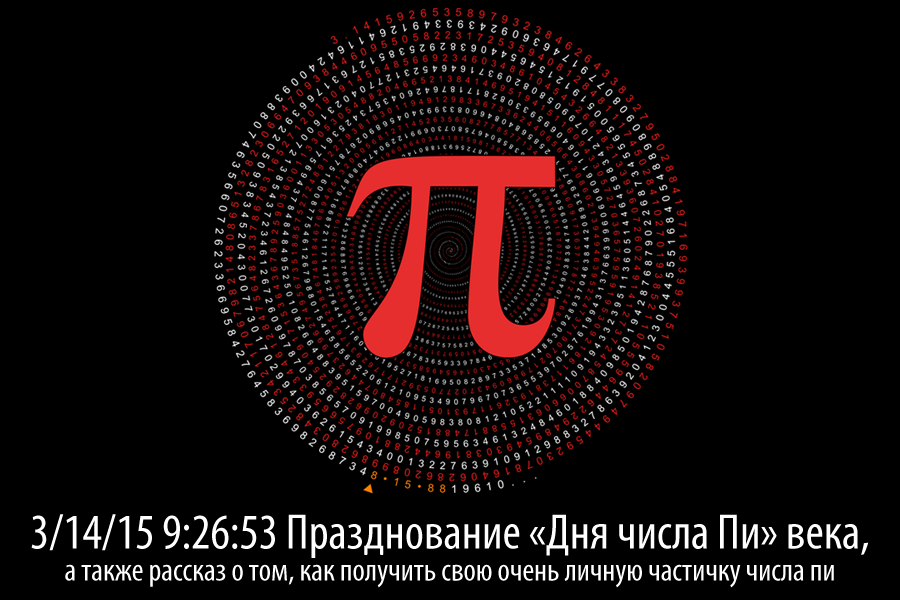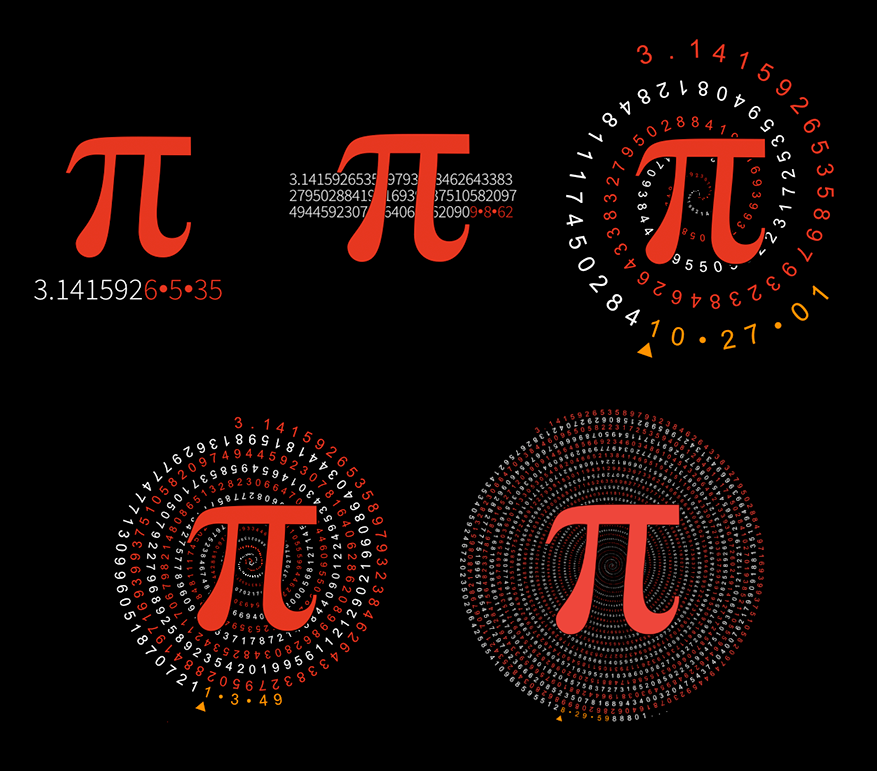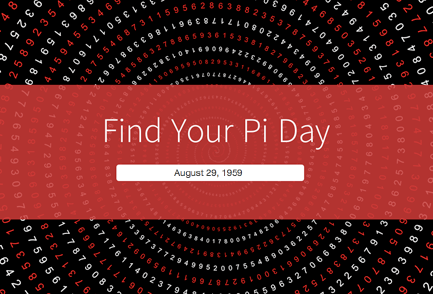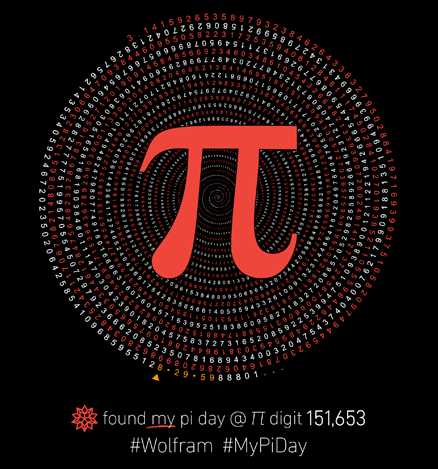3/14/15 9:26:53 Century Celebration of the "Day of the Pi Number", as well as a story about how to get your very personal piece of pi

Translation of Stephen Wolfram's post (Stephen Wolfram) " Pi or Pie ?! Your Day of Own Piece of Pi "
I express my deep gratitude to those who helped me to make this translation: Kurban Magomedov and Olga Lavrenyuk .
This Saturday will be the "Day of Pi" century. Date 3/14/15 in the month / day / year format specifies the first digits of the number π = 3.1415 ... A 9: 26: 53.589 ... in the morning will be "the super moment of the day of Pi".

Thanks to Mathematica and Wolfram | Alpha , I’m sure that our company has given the world π more times than any other organization in history. So, of course, we have to make some kind of special (event SXSW) for this special Day of Pi.
')

Corporate confusion
One of my tasks as a CEO is to come up with ideas and I spent decades building an organization that would put them into practice well. So, a few weeks ago, I attended a meeting dedicated to future corporate events and someone noticed that Pi Day (3/14) will take place during the big annual SXSW festival (South by Southwest) in Austin, Texas. I said (well, or at least I thought I said it), “We must use the untranslatable word game pi - pie, which is important in the future> .
I did not think about it anymore, but after a couple of weeks we had another meeting about the current affairs of the company. One of the items on the agenda was just Pi Day. The person who leads our group, responsible for all sorts of activities, began to talk about the fact that it would be difficult to find a bakery in Austin that would make a fairly large pie. I exclaimed, “What are you talking about?” And then added “You didn’t understand what I meant at all!”.
I think that in our <English-speaking> world the problem of what is meant by Pi is very common. The speech recognition system in Siri sends to Wolfram | Alpha a multitude of requests for "pies" (pie) , which we must interpret as the number Pi (pi) . There is also a single-board computer Raspberry Pi , on which the Wolfram Language is preinstalled. In my life, there is even more confusion that my personal file server for many years was called “pi”.
After this error pi (e), we continued the meeting and came up with many ideas on how to celebrate Pi Day. We already rented a small venue in the SXSW festival area and we wanted to make the most interesting “countdown to Pi Day”, which we can do. We decided to make a large number of edible "pixel" cakes, which will be combined in the form of Pi in one big cake. Of course, there will be a special platform for Pi-selfie in the form of “Stonehenge-like” Pi number, as well as a cake decorated with Pi number in the form of Wolfie <Wolfram Language> logo for additional selfies. And of course we will do different things on the Raspberry Pi.
A bit of Pi for each
I’m sure that at the SXSW festival we will all get a lot of pi fun. But we also want everyone in the world to take part in the celebration of Pi Day. We were tormented by the question "What could someone do with pi?". In fact, in a sense, everyone can do anything with Pi. Let us say, besides the fact that the number Pi has infinitely many signs in its record, their infinite sequence, as a whole, is completely random . For example, it will meet any pre-set sequence of numbers.
How about giving people a personal connection to this part of mathematics? The day of Pi occurs on the day that corresponds to the first digits of Pi. But any date is present somewhere in the record of Pi. So, we thought: “Why not give people the opportunity to find a place where their birthday (or any other date) is found in the record of Pi number and then create, say, personalized pi-shirts and pi-posters?”
In the Wolfram Language language, it is very easy to find the position that your birthday in the number π "occupies". In general, any date in the format mm / dd / yy will be found among the first 10 million characters of Pi. On my desktop computer (Mac Pro), the calculation of these 10 million characters of Pi took 6.28 s (2π ?!)
Below is the code in the Wolfram Language language, which allows you to get this result and present it as a string (discarding the separation of the integer and fractional parts, which is in second place in the resulting string):
Now it’s easy to find any “birthday string”

So, for example, my birthday is met for the first time in the record of the number π starting with the number 151 653.
How to visualize it? It depends on how “pi lucky” you are. For example, for those who were born on 4/15/92, their birthday is already found at position 3. People born on November 23, 1960 have a “birthday string” that starts only from 9 982 546 characters of Pi. In this case, in fact, most people have birthdays that are “quite far” in writing the number π (on average, these positions are around 306 150).
Our main artist, who has been working with us for a very long time, had the idea to use a spiral that twists first inward and then outward in order to display the beginning and end of such long sequences of numbers. And almost immediately he wrote the code that creates it (one of the most amazing things about the Wolfram Language is that even people without technical education can easily write their own code ...).

He then deployed his code online. Thanks to the Wolfram Programming Cloud , this was essentially done in just one line of code. Now, you can go to this site MyPiDay.com ...

... and get your own piece of pi!

After that you can share the resulting image or order a t-shirt with it:

Science of Pi
Although we already talk a lot about Pi, I can’t resist telling a little about Pi from a scientific point of view. But, to begin with, we will answer the question: why is the number Pi so well known? Yes, this is the ratio of the circumference to its diameter. And this in itself means that the number Pi is found in billions of scientific formulas . But that's not all. (Say, for example, most people have never heard of an analogue of the number π for an ellipse — about the so-called full elliptic integral of the second kind).
More interestingly, the number π is found in a significant number of mathematical constructions — including many that seem to have nothing to do with circles. Such as, say, the sum of negative degrees or the limits of some sequences, or the probability that a randomly chosen fraction will be irreducible.
If you just look at the sequence of digits of Pi 3.1415926 ...., then at first glance there is nothing special about it. But let's say we begin to create formulas at random and then we will perform traditional mathematical operations on them, such as, say, summing series, searching for integrals, limits, etc. We will get a lot of answers like 0 or 1/2 or
Several other constants will also appear frequently, say, the number e (2.1718 ...) , the Euler constant — Mascheroni (0.5772 ...), or the Catalan constant (0.9159 ...) . But the number π appears more often .
Perhaps mathematics could have a different look . But, at least with the math that we, the people, have created, the number π is a very common building block, and it’s quite natural that we gave it a name and that it became known so much that we allocated a separate day to celebrate this number.
What can be said about other constants? "Birthday Strings" will, of course, occur in different positions of different constants. And, just as the Wolfram | Alpha service tries to find a closed form for some decimal fraction , you can also find the position of a certain sequence of digits inside other constants. So, for example, my birthday is found at position 151,653 in the number π, 241,683 in the number e , 45,515 in
Accident in the number of π
Let's, let's say, build a graph of a function that increases whenever the digit of the number π is greater than or equal to five and decreases otherwise:

The graph looks like a random walk. At the same time, all statistical and cryptographic tests for randomness, which were carried out on the digits of Pi (excluding tests that simply ask, “Isn’t it digits of pi?”) Confirm this assumption.
Why is this happening? There are simple procedures that generate digits of pi. But it is striking that even though these procedures are simple, the result of their implementation is complex to such an extent that it seems completely random. In the past, there were no circumstances in which people would reason about such behavior. But I spent many years studying this kind of systems and wrote the book A New Kind of Science . In a sense, the fact that anyone can find their birthday in the record of Pi is directly related to concepts, such as, say, " The Principle of Computational Equivalence, " which I put forward in my book.
SETI and digits of pi
Of course, just because we have never seen any pattern in the numbers of Pi, this does not mean that there is no such pattern. In fact, it is still possible that if we did a sufficiently large search, we could find somewhere far away in the digits of Pi some sort of lurking, strange pattern.
What would it mean? There is a science fiction answer given at the end of the book version of Carl Sagan's Contact . In the book, the search for extraterrestrial intelligence ends by making contact with an interstellar civilization that created amazing artifacts — after which it is explained that the most important thing that was discovered was encoded just in the distant digits of Pi, in which they found sensible messages, such as, say , encoded image of a circle.
At first, one might think that the search for "reason" in the digits of Pi is absurd. After all, in the end, there is a well-defined simple algorithm that generates these numbers. But if my suspicions on this score are true as well as the suspicions about our entire Universe , then in fact every detail of its history is, in principle, computable, just like the digits of Pi.
Now we know that in our Universe we ourselves act as an example of the mind. SETI (Search for Extraterrestrial Intelligence) is just trying to find other examples. This task is well defined if we are looking for the “mind of the human type.” But, in accordance with what my Computational Equivalence Principle implies, I think that, in general, it is almost impossible to make an exact distinction between what should be considered “reasonable” and what is considered “just computable”.
If the age-old mathematical suspicions that the digits of Pi are “normal” are true, then it will automatically mean that any sequence of digits is sure to occur sooner or later among the digits of Pi, including all the works of Shakespeare, or any other heritage of any possible civilization. But can there be any other structure - perhaps even superimposed on normality - which, for example, can serve as evidence of the emergence of "reasonable" complexity?
Although it may be conceptually simple, of course, it seems much more strange to look for the possibility of the existence of a reasonable human-like civilization in numbers of Pi than in the physical Universe observed by SETI. But if we summarize what we see as reasonable, the situation becomes much less obvious.
Of course, if we observe a complex signal from the magnetosphere of a pulsar, we say that it is "just physics" and not the result of the evolution of a "magnetohydrodynamic civilization". Similarly, if we observe some complex structure in the figures of Pi, we say that it is “just mathematics” and not the result of the life of a certain “number-theoretic civilization”.
We can move from a sequence of digits of the number Pi to representations of any mathematical constant that can be easily defined using traditional mathematical operations. In some cases, there are certain patterns in such representations. But often everything looks again by chance. And the project of searching for a structure in such cases is generally similar to the SETI project in the physical Universe. (One of the differences, however, is that the number π, as an object of study, was chosen by us as a result of the structure of our physical Universe, our brain and our mathematical development. The universe itself probably does not have the ability to make such a choice, which is given to us implicitly due to the fact that we exist in it.)
I spent a lot of time looking for patterns in representing numbers such as Pi. I have not found anything substantial. I think it is needless to say that any patterns are generally easy to find. And there is a possibility that it will take efforts, as great as in the SETI project, to detect them.
But for now, let's celebrate the Day of Pi in our century and enjoy things like the search for "birthday lines" in the record of pi . Of course, someone, like me, can only hope that by the next Day of Pi-century , which will take place in 2115, we will succeed in the SETI project or “SETI among the numbers” ...
Resources for learning Wolfram Language (Mathematica) in Russian: habrahabr.ru/post/244451
Source: https://habr.com/ru/post/252947/
All Articles